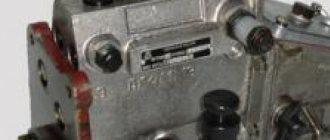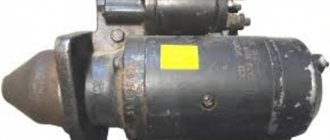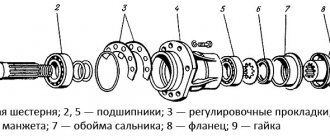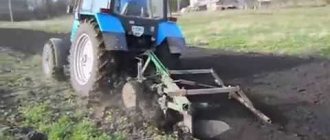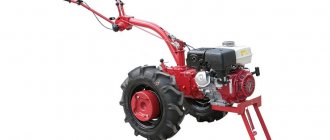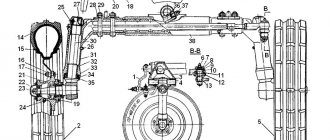The birthday of ChTZ is considered to be June 1, 1933, but the first caterpillar tractor was produced on May 15. This machine was called “Stalinets-60” and was a localized copy of the American Caterpillar 60 with significant modifications. Specialists from different countries, including the USA, took part in the construction of the plant. The well-known “Pamir Crossing” worked on the plant project.
The next significant date in the history of the enterprise is considered to be 1937, which marked the beginning of the serial production of the Stalinets-65 tractor. Shortly before this, or rather in May of the same year, this tractor received the highest award at an exhibition in Paris - the Grand Prix diploma. The tractor ran on diesel fuel, and it is worth noting that ChTZ is considered to be a pioneer in the diesel industry of the USSR. In the pre-war years, the plant began to actively develop the production of military equipment, and in 1939 the tractor for army equipment, “Stalinets-2” (power 105 hp), was produced. A year later, in 1940, ChTZ produced its first KV tank. In the same year, a significant event occurred in the history of the plant - the hundred thousandth tractor rolled off the assembly line.
↑ History of the Chelyabinsk Tractor Plant
The history of the plant began with the Council of People's Commissars. On May 29, 1929, the Council adopted a resolution on the construction of a tractor plant, the planned capacity is 40 thousand machines per year. The task is more than ambitious.
The design of the plant was carried out by an American from the city of Detroit together with Soviet engineers and architects. The American Firm was led by architect Albert Kahn. This is a real name in the history of architecture. A. S. Fisenko, V. Shvetsov and A. Velichkin were responsible for the design.
Already on May 15, 1933, the first tractor rolled off the assembly line of the plant. The model was called “Stalinets-60”, and its prototype was the American “Caterpillar 60”. The grand opening of the plant took place on June 1, 1933. Since then, the dynamic development of the plant began.
Chelyabinsk Tractor Plant photo
In 1936, tractors took part in a grandiose event - the “Snow March”. The cars had to travel 2 thousand kilometers across Yakutia. 50 degree frost, harsh roads - the tractors coped with all the obstacles that befell them. In the pre-war years, more than one hundred thousand cars came out of the factory gates. Model S-65 was on display in Paris. This is a great recognition for the plant and the entire Soviet industry.
Bad advice from an experienced BA, part 2: the client’s pain is more important than the Customer’s wishes - TK and CHTZ
Today we will look at how the Client differs from the Customer, whose requirements are more important and how to specify them in the form of a private technical specification. What is a ChTZ and how to compile it: practical recommendations for beginning business analysts with examples, as well as links to GOST and BABOK®Guide.
Customer vs client: what is the difference and what BABOK®Guide says
In consulting and custom IT development, some projects are quite long and aimed at solving strategic problems. For example, developing an enterprise development strategy, creating a digitalization program or research work. In such cases there is not always a clear vision of the final product, i.e. what kind of result you need to get. In this case, an agreement for the performance of work or the provision of consulting services is concluded, and as an annex to it is a technical specification (TOR), drawn up according to the template GOST 34.602-89 and 19.201-78.
However, despite filling out all the points indicated in these standards, it is impossible to launch this document into implementation, because the requirements, constraints and goals described therein are too abstract. For example, “the graphical user interface should be convenient and intuitive,” “the purpose of the system is to minimize the number of manual operations performed by the business user,” “the procedure for processing personal data must comply with the Legislation,” etc. and so on. Such technical specifications are formal in nature and require clarification, which is usually implemented in the form of a technical specification or a private technical specification. GOST 34.602-89 notes that additional specifications can be developed for parts of the automated system, including software, which will clarify the primary requirements.
Development of technical specifications for an information system in accordance with GOST and SRS
Course code
TTIS
Nearest course date
April 25, 2022
Duration of training
12 academic hours
Cost of education
20,000 rub.
In practice, especially when working with large government projects, managers most often participate in the development of technical specifications, rather than analysts and subject matter specialists. This situation is typical for open tenders and competitions for research work. Therefore, the first task of the analyst after receiving such technical specifications with a very high level of abstraction is to “get it down to earth”, i.e. identification of requirements and their formulation in the form of CTZ. Most often, there is a change in the responsible stakeholder: at the “head” level, i.e. At the primary TK level, we deal with the Customer, and at the ChTZ level, with subject matter experts and end users of the product.
For example, the Customer speaks beautifully about digitalization, a unified information space, end-to-end analytics and a 50% increase in profits due to increased labor productivity. And in the very first interview with the Client, it turns out that there is a need for integration of existing information systems, regulations for the execution of business processes, clear dashboards for tracking key indicators of management accounting and operational metrics, as well as automation of routine tasks.
Thus, the analyst comes to the need to separate the Customer and the Client, deciding with the first the formal stages of accepting the work, and with the second - the specifics of immersion in the result, including clarification of requirements. This division is not reflected in the BABOK®Guide, where the term Customer refers to a stakeholder who uses the products or services of an enterprise with contractual or moral rights that it is obliged to respect. This definition is close to the concept of “Customer” from the Civil Code of the Russian Federation, which applies it to a narrow range of transactions for the performance of work or the provision of services. For example, contract agreements, research, development and technological work, supply of goods, as well as paid services for state and municipal needs.
Storming BABOK in 5 days - preparing business analysts for the CBAP/CCBA certificate exam (IIBA® Endorsed Course, 40 PD)
Course code
CBAB
Nearest course date
April 4, 2022
Duration of training
40 academic hours
Cost of education
75,000 rub.
In particular, the Customer in a software development project can be a state-owned enterprise or the head office of a large corporation. The customer of a business analysis course can be an individual who wants to give training to his colleague. The consumer of services is often called the Client - the one who accepts the product and the one whose needs it must satisfy. Therefore, the requirements of these stakeholders should be given special attention, which we will discuss next.
What is ChTZ and how to compose it
If we understand the Customer as a legal or natural person who expresses wishes, sets deadlines and pays money, and the Client as the one who formulates the requirements for the result and accepts it, the division of areas of responsibility becomes clearer. For example, in terms of the RACI matrix, the Customer will have the role of Informed (I), and the Client will have the role of Consulted (C). For more information about what a responsibility matrix (RACI) is and how it differs from a table of CRUD operations, see here.
Thus, the primary (head) TOR describes the Customer’s requirements, which are rather wishes with a high level of abstraction, and the CTK describes the direct requirements for the solution (functional and non-functional), resulting from the Client’s business needs and requirements. It is the CTZ that most often represents a document of user requirements in the form of a Use Case, as well as a description of system restrictions, dependencies, domain entities and relationships between them, including UML diagrams and prototypes of screen forms - i.e. everything developers need to start implementation. Such private technical specifications are most often built according to a template based on SRS according to ISO IEEE 29148-2018, which I presented in this article.
Of course, the ChTZ should refer to the head TK. This is usually done at the beginning of the document, for example, in the Introduction section, paragraph “Basis for development”. This can be done with the following formulation:
The basis for development is contract/agreement No. dated _______ year for the performance of work on _____________________ (hereinafter referred to as the Contract). This Particular Technical Specification has been developed in accordance with the requirements of the Technical Specification for the performance of work on _____________________. General requirements for the system must comply with the Terms of Reference for the work _______________ (Appendix No.__ to the Contract). Specific requirements are reflected in this ChTZ.
In terms of the product approach, we can say that the technical specification is the product road map (Product RoadMap), and the technical specification is the release plan. Or another analogy that everyone understands: TK is the basic Law (Constitution), and ChTZ is the laws of the Codes (Civil, Labor, Tax, Housing, Budget, Criminal, etc.).
In conclusion, I note that it is useful to describe in the ChTZ the criteria for accepting results according to the concept of Definition of Done. They can be identified at the stage of requirements validation as part of the joint work of a business analyst with the Client - a subject matter expert and the end user of the product. You will learn how to do this in practice, draw up a working TK and CTZ, and also understand the types and forms of presenting requirements in the course “Development of TK for an information system” at our School of Applied Business Analysis in a licensed training center for training and advanced training of system and business analysts in Moscow.
To check how well you have mastered the material in this article, we suggest you independently complete an open interactive test on your knowledge of technical specification development standards and software requirements specifications.
And to fully master the contents of the guide to the professional body of knowledge in business analysis, prepare to pass the IIBA certification exam on BABOK®Guide at the CBAP, CCAB, ECBA levels, having received the necessary hours of professional development, I offer authorized courses from our School of Applied Business Analysis in a licensed educational Center for training and advanced training of system and business analysts in Moscow:
- Assault on BABOK®Guide in 5 days: preparation for the CBAP/CCBA exam (Endorsed course, 40 hours PD from IIBA)
- Express training on BABOK®Guide: preparation for the ECBA exam in 3 days (Endorsed course, 24 hours PD from IIBA)
- Business Analyst Toolkit: BABOK Techniques
SIGN UP FOR TRAINING
↑ Chelyabinsk Tractor Plant during WWII
Shortly before the start of the Great Patriotic War, the plant began producing military products. The first military vehicle to roll off the production line was the Stalinets-2 artillery tractor. And just before the start of the war, the plant mastered the production of the famous KV tanks.
During the Great Patriotic War, the plant launched the production of artillery tractors and KV-1 heavy tanks, and they also did not forget about tractors. After the first failures of the Soviet army, the evacuation of factories began from cities. Some of them were evacuated to Chelyabinsk. ChTZ was renamed the Kirov Plant of the People's Commissariat of Tanks and Industry.
The evacuated factories became a real tank plant, which was popularly nicknamed “Tankograd”. During the years of evacuation, Tankograd produced 13 new types of tanks and self-propelled guns, and six new diesel engines. Surprisingly, it was here, and even during the war years, that for the first time in the world, the assembly of a heavy tank was put on an assembly line.
In the period from 1941 to 1945, the plant was awarded the Order of the Red Star, twice the Order of Lenin, and the Order of Kutuzov, 1st degree. The Motherland appreciated the labor feat of the plant and its workers.
ChTZ during the Great Patriotic War
During the war years, ChTZ was renamed the Kirov Plant of the People's Commissariat of Tank Industry in the city of Chelyabinsk. The plant received this name due to the fact that other large plants from all over the union were evacuated to Chelyabinsk, there were 7 of them in total, among them was the Leningrad Kirov Plant. They formed a plant for the production of tanks and military equipment with the unofficial name “Tankograd”. In a very short period of time, the plant became one of the main suppliers of military equipment and supplies to the front. At ChTZ, completely new types of tanks, self-propelled guns, and tank diesel engines were created. During the war, the plant repeatedly received all-Union awards.
Read Fast Neutron Reactor BN-800
↑ Chelyabinsk Tractor Plant after the war
After the war, the country returned to peaceful life. The tractor plant was put on civilian footing. In January 1946, the first post-war civilian tractor, the Stalinets-80 (S-80), rolled off the assembly line. Subsequently, during the Soviet period of history, the plant established mass production of such models as: S-100, DET-250, T-100M, T-800, DET-250M2. Tractors produced within the walls of the plant took part in the development of hard-to-reach areas. Plowing, land, development of virgin lands - ChTZ tractors took part in everything.
Plant in the post-war years
Soon after the end of the Great Patriotic War, in 1946, the plant produced two new tractors, S-80 and S-100. Three years later, in 1961, the DET-250 tractor was sent into mass production. In the post-war years, ChTZ continued to actively develop and in October 1963 the plant launched the production of T-100M tractors, they had quite a lot of power - 108 hp. This copy became the hallmark of the enterprise; its production was the most massive in its entire history (over 400 thousand tractors were produced). The T-100M tractor had 22 designs, each of which was designed for different weather, operating and temperature conditions. At the end of the 60s, the T-100M tractor was significantly reconstructed, as a result of which the T-130 tractor came off the assembly line.
In 1971, for the first time in the USSR, the association of tractor and agricultural engineering “Chelyabinsk Tractor Plant named after V. I. Lenin” was created. In 1982, a monument to the S-60 military tractor was erected on Mount Elbrus, which was practically destroyed as a result of hostilities. ChTZ is the manufacturer of the T-800 tractor; this tractor has no analogues in the whole world. It has a power of 820 horsepower and is designed to move very heavy frozen rocks and rocks. In 1990, this machine was included in the Guinness Book of Records for its extremely high performance and large dimensions.
↑ New history of ChTZ
After the collapse of the Soviet Union, ChTZ was privatized and turned into a joint-stock company. In this he repeated the fate of most factories and enterprises. ChTZ became known as URALTRAK OJSC. Four years later, by decision of the shareholders, the plant again changed its name to “Chelyabinsk Tractor Plant”.
In 1998, an unprecedented crisis broke out in the country, the state declared itself bankrupt, and a default occurred. The plant faced the same fate - bankruptcy. The enterprise was reorganized and rose from the ashes under the name of ChTZ-Uraltrak LLC. Since then, things have been improving at the plant. The V-92 S2 tank diesel engine, T10, DET-320, T10M tractors went into serial production. In 2011, ChTZ became part of Uralvagonzavod.
On the basis of ChTZ, with the support and management of Uralvagonzavod, a heavy engineering division is being formed. ChTZ is undoubtedly a market leader, whose products are in demand in Russia, the CIS countries and Asia.
Modern stage
Since 1992, the plant has changed its name several times. On October 1, 1992, ChTZ received the name “URALTRAK”; this decision was made at the board of shareholders. After 4 years, the plant was again renamed “Chelyabinsk Tractor Plant”. In 1998, ChTZ became bankrupt and was reorganized, and on its basis a new enterprise appeared: ChTZ-Uraltrak. In subsequent years, the plant worked actively and in March 2011 it was actually bought out (63.3% of shares) by Uralvagonzavod. As part of this plant, ChTZ was to become the main enterprise for the production of civilian equipment. The plant began to actively enter into export contracts with many countries around the world. Over its history, the plant has been awarded many All-Union and Russian awards and received many international certificates confirming the quality of its products.
Read SK Zvezda - The future of Russian shipbuilding
Today, ChTZ is developing very actively and is one of the largest enterprises in the Russian Federation. It is worth noting that with the entry of ChTZ into Uralvagonzavod, the enterprise began to develop more rapidly. If we talk about development prospects, the latest investments in the enterprise amounted to more than 17.5 billion rubles. The plant's activities are actively aimed at producing road construction equipment. The plant plans to produce 3 thousand tractors every month. Our immediate plans include replacing outdated equipment with more modern and multifunctional ones. This gives engineers and plant specialists a lot of room for thought. They will be able to design completely new equipment.
In 2014, the company experienced significant financial difficulties, but now ChTZ regularly pays decent wages to all employees. In general, the plant is constantly actively developing. The economic strategy of the plant is aimed at restructuring and creating an effective management tool. The plant is constantly mastering the production of products that were previously supplied from outside. This allows us to significantly improve the quality of products, as well as expand the scale of production. In principle, this strategy has been followed throughout the history of the Chelyabinsk Tractor Plant.
By modern standards, ChTZ produces very good machinery and equipment, which are characterized by high efficiency, power and comfort (applies to new tractors and bulldozers). Foreign experts highly appreciate the technology of the Chelyabinsk plant, noting that it is no longer inferior to overseas Caterpillars. Now we can say that all the changes and reconstructions that were carried out not in the best years of the enterprise have borne fruit. ChTZ is constantly modernizing and strengthening ties with foreign countries.
↑ ChTZ products
The Chelyabinsk Tractor Plant produces a wide range of construction equipment. Equipment of the highest quality and reliability.
ChTZ tractors:
- Tractor T10M (basic model)
- Tractor T10MB (swamp)
Bulldozers:
- Bulldozer B10M (Manual transmission
- Bulldozer B10M.6100
- Bulldozer B10M with hydromechanical transmission
- Bulldozer B10M2
- Bulldozer B10MB (swamp)
- Bulldozer B10M with traction winch
- Bulldozers B10M2S and B12S
- Bulldozer B11
- Bulldozer B11.8000
- Bulldozer B12
- Bulldozer B14
- Bulldozer-loosening unit DET-250M2
- Bulldozer-loosening unit DET-320
- Bulldozer-loosening unit DET-400
Pipelayers:
- Pipelayer TR20.22.01
- Pipelayer TR12.22.01
Front loaders:
- Front loader PK70 / PK70K
- Front loader PK-65
- Front loader PK-55
- Front loader PK-46
- Front loader PK-30
Compactors:
- Compactor BKK2
Reclamation and forestry equipment:
- B10M tractor with mulcher
- Tractor B10M with uprooter
- Bulldozer for forestry
- Trench excavator based on the ChTZ tractor
- Sewer cleaner based on the ChTZ tractor
- Cavalier levelers based on ChTZ tractors
- Bulldozer B10M with wedge pusher
- B10M tractor with a plow.
Amazing logistics operation to transport factories
In September-October 1941, the evacuation of two huge enterprises began to Chelyabinsk - the Kirov Plant from Leningrad and the Kharkov Diesel Engine Plant No. 75 from Ukraine. There were no precedents either in domestic or in world practice when such giant factories with their teams of many thousands were “removed from the foundation” in a matter of days, loaded into trains, and after a short time they practically started production off the wheels many thousands of kilometers from the place of construction. . Such measures were forced and one can only appreciate the heroism and fortitude of the people who carried out such complex operations in the shortest possible time.
Kharkov Motor Plant No. 75 was evacuated under the bombing of fascist aircraft. It was a carefully thought-out operation carried out with great heroism. The last trainload of factory equipment left Kharkov on October 18, 1941, just a week before German tanks entered the city.
In an even more difficult situation, the evacuation of the Kirov plant was carried out. In October-November 1941, all seats on planes leaving Leningrad surrounded by the Nazis to the mainland were given to workers and specialists of the Kirov plant, who were then urgently sent by rail to Chelyabinsk. Over 15 thousand plant workers and members of their families were transported to the Urals. Trains with Leningraders arrived in Chelyabinsk from October to December 1941 and even in January 1942. The main composition of the leading tank workshops of the enterprise was staffed by workers and specialists from the Kirov plant.
By January 1942, 29,850 people had arrived at the plant. 8 thousand of them were placed in the city, 17 thousand - in factory houses, 3,800 people - at evacuation points - in the factory, factory club and school No. 52 (now No. 48).
Living conditions were incredibly difficult. Winter, lack of fuel, because... There was nowhere for people to get it. The factory village was undergoing its sixth (!) compaction, everything was packed to capacity. There were no mattresses, and hundreds of people slept in cold barracks on bare boards. There were not enough canteens and hairdressers, the bathhouse was unable to serve the sharply increased number of people, there was nowhere to repair shoes and clothes. But all everyday problems in those days faded into the background. The front demanded: “Give me the tanks!” Quicker! Immediately!".

